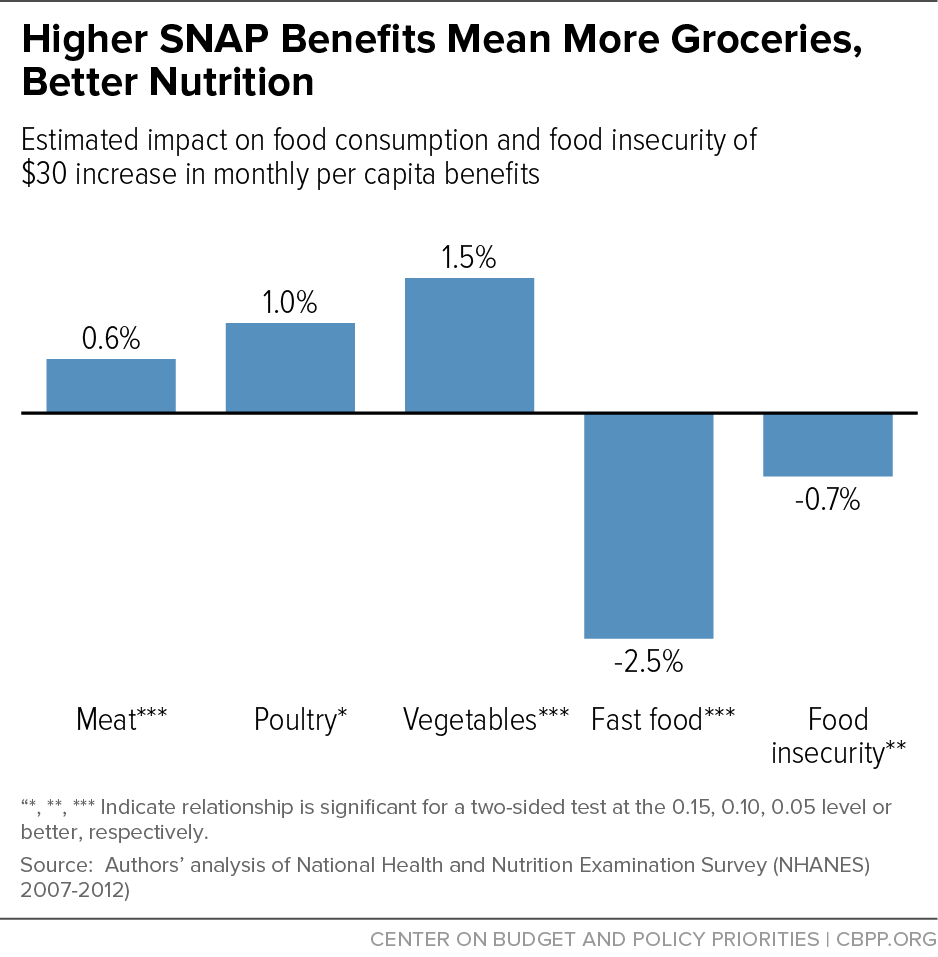New research finds that raising SNAP benefits would not only increase low-income households’ spending on food but also improve the nutritional quality of their diets.[1] The study, by economists Patricia M. Anderson of Dartmouth College and Kristin F. Butcher of Wellesley College, finds that a $30-per-person increase in monthly SNAP benefits would:
- Raise recipient households’ grocery spending by about $19 a month per person. This is less than the SNAP benefit increase, even though SNAP can be spent only on food, because the added benefits would free up some household income for other necessities, such as utility bills or non-food items that SNAP doesn’t cover.
- Increase consumption of more nutritious foods, notably vegetables (including tomatoes and yellow vegetables) and certain healthy sources of protein (such as poultry and fish).
- Reduce consumption of fast food, while increasing the amount of time households spend shopping for and preparing food.
- Reduce “food insecurity,” which occurs when families have trouble affording adequate food at some point in the year. (See Figure 1.)
Low-income families report that to meet their food needs, they would need to spend an additional $4 to $9 per person per week on food, or about $17 to $40 per month. Food-insecure families, who are more likely to be poorer, report needing an additional $12 to $20 per person per week (about $50 to $85 per month). Moreover, the categories of households that are more likely to be food insecure, such as those headed by people with disabilities, women, African Americans, or people who haven’t completed high school, also are more likely to report needing a larger amount of additional money to cover their food needs than otherwise-similar households.
SNAP benefits, which average about $1.40 per person per meal, are based on the cost of the Thrifty Food Plan (TFP), a low-cost but nutritionally adequate diet established by the Agriculture Department. Several recent studies have called for reexamining the TFP based on evidence that SNAP benefit levels may be inadequate.[2] The $30-per-person monthly increase in SNAP benefits discussed in this study would represent roughly a 20 percent increase in the cost of the TFP.
This study’s finding that the bulk of a household’s additional resources resulting from a SNAP increase would go to food purchases highlights the significant constraints on these households’ food budgets. Households would use only about 35 percent of the additional resources for other purchases, such as rent, gasoline, or household goods.
In addition, the finding that households, if given additional resources for food, would spend them on more nutritious foods that may yield better long-term health outcomes is consistent with recent research comparing the long-term outcomes of people in different geographic areas when food stamps gradually expanded nationwide in the 1960s and 1970s. Children who had access to food stamps in early childhood and whose mothers had access during pregnancy had better health and educational outcomes as adults than children without access to food stamps.[3]
The study estimates how SNAP recipients would respond to a benefit increase by using standard statistical techniques (regression analysis) and data from federal household surveys, described below. The analysis assumes that the food purchasing choices of households that spend slightly more on groceries are a good predictor of how households with slightly lower grocery spending would behave if given more resources. The data include:
- Current Population Survey (CPS), an annual U.S. Census Bureau survey with information on household income, SNAP receipt, food bought at stores, and food insecurity, as well as numerous other household characteristics. Using this data, the researchers predict that per-person spending on groceries would rise about $0.65 for each $1 increase in per-person monthly SNAP benefits — corresponding to $19.48 higher spending for $30 in additional SNAP benefits — after controlling for certain household characteristics. The CPS also is the source of information about household reports on how much additional resources are needed to provide sufficient food for their members.
- National Health and Nutrition Examination Survey, a Centers for Disease Control and Prevention survey with information on households’ health and nutritional status, including grocery store spending (including food bought with SNAP) and food consumption, as well as food insecurity. The researchers use this data to simulate the impact of an increase in grocery spending on consumption of various foods and other outcomes, including food insecurity.
- American Time Use Survey, another U.S. Census Bureau survey with information about the time people spend on various activities, including purchasing and preparing food.
This study is the first to link these data sets to explore questions about the relationship between SNAP benefit levels and nutrition outcomes. It also is innovative in examining the CPS household reports of the amount of additional resources needed for food.

